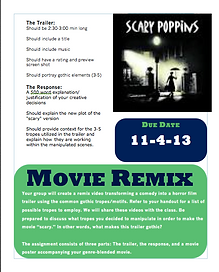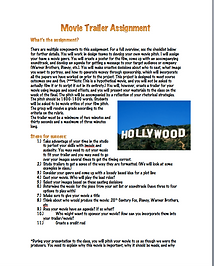Student Gallery of New Media Projects
Videos|Infographics|Magazine Covers|Memes|Movie Posters| Commonplace books
The Gathering
Winner of Best Movie Trailer Spring 2014
Rhetoric and the Cinema 20803
Cameron
Winner of Best Movie Trailer Fall 2014
Rhetoric and the Cinema 20803
Farmers and Shepherds
Winner of Best Trailer Fall 2013
Rhetoric and the Cinema 20803
Repercussion Films:Studio Logo
Rhetoric and The Cinema 20803
Summer 2013
Airplane Genre Blend
Rhetoric of the Cinema 10803 Spring 2015
Zombie Chaos
Winner of Best Trailer Spring 2013
Rhetoric and The Cinema 20803
Scary, Scary Movie Genre Blend
Rhetoric of the Cinema 10803 Spring 2015
What Mentorship Means to Us
Intro to Women's Studies WOST 2003
The Importance of Mentors
Intro to Women's Studies WOST 20003
Wise Woman Video
Women Writers Spring 2014
Wise Woman Video
Women Writers Spring 2014
Info graphics from Intro to Women's Writing 20623 and Rhetoric and the Cinema 10803
 Maxim featuring Velma |  Men's Health featuring Johnny Bravo |  Cosmopolitan featuring Belle |
|---|
Magazine Covers from Rhetoric and the Cinema 20803
Children's Unit: Problematizing issues of Gender and Beauty Standards in children's movies
Movie Posters: 20803 &1080 Rhetoric of the Cinema


 The Princess Effect |  50 shades of effects |  Barbie |
|---|---|---|
 The Ugly Truth |  Women Writers |
Memes from Rhetoric of the Cinema 10803 & 20803

Sponge Bob Genre Blend
Rhetoric of the Cinema 10803 Spring 2015
To view assignment sheets and rubrics for these projects, please click on the corresponding images below.
Context
As an extra credit assignment, I asked the students to produce their own visual arguments in the form of a magazine cover. The assignment was given during our children’s unit in which the class was dissecting both cliché and problematic messages presented in children’s films. Most chose to do the extra credit assignment over a particular Disney movie. The example to the right examined the darker side of having Belle fall in love with her captor, the beast. In her accompanying response she discussed how some might view the Beast and Belle’s romance as a means of reinforcing abusive relationships: “If your man is verbally or physically abusive to you, you just aren’t loving him enough.” The image on the left was an interesting look at how women are portrayed in Scooby Doo. By placing Velma on the cover of Maxim, the student points out how even the seemingly “nerdy” character is oversexed. Finally, the middle image, created by one of my male students illustrates that the issue of body image in cartoons is not only problematic for young women but young men as well. In his response, he discussed how these unrealistic standards imply "real men have muscles" and make men "feel ashamed" to take off their shirts at the pool if they don't look like Johnny Bravo. I was impressed with all the visual arguments I received, and I was equally impressed with the time and energy the students put into the project considering it only replaced one blog grade, which was 3% of their overall grade.
Meeting Goals and Oucomes
Students will be able analyze rhetorical situations
The project asks students to analyze the rhetorical situation of a magazine cover and how it constructs arguments or the ploys it uses to grab readers’ attention and convince them to read further. Unfortunately sex sells, and students were able to pick up on the rhetorical strategy of using sexual appeal to attract readers while simultaneously constructing their own arguments about how Disney or Universal Studios also use sex as a ploy or an implied argument throughout the film. I believe these covers subtlety suggest how these themes of beauty and sexuality could be problematic for young viewers.
Students will demonstrate facility with the language and analysis of argument.
While this is not a traditional paper, it does allow students to hone their facility of language because of the specific nature of a magazine cover. They must choose their words carefully in order to attract attention from the audience and the words must concisely explain the main idea of the story while simultaneously leaving the reader wanting more. In some ways, this assignment is more challenging than a paper in terms of analyzing the rhetorical situation.
Students will reflect upon the media’s use of argument in everyday life.
I hope meeting this goal is self-evident. Students were asked to choose a magazine and analyze the strategies it uses to gain readership, paying particular attention to the cover. Students then selected a movie and dissected the messages presented about relationships, beauty, and sexuality. Thus, students engaged with two different types of media and showcased how the media communicates ideas both implied and overt to the public.
Students will demonstrate competency in using sources (primary, secondary, and electronic) in argument construction.
Though there was not an official works cited sheet for this project, students did work with primary materials (magazine and movie) in order to construct their own argument about both industries.
Context
At the end of the semester, I asked students to create an infographic connecting to a theme or a particular reading from our course. They were required to use five outside sources to help them get information to include on the infographic, and they had to write a 300-500 word reflection of the project, explaining what drew them to this topic / what reading inspired further study and discussing their creative choices. In one of the examples provided, the student chose to create an infographic about both the positive and negative influences of Barbie after reading “My First Black Barbie” by Sharon Rainer.
Goals and Outcomes Met
Students will demonstrate an understanding of literature as it impacts and/or reflects society and the individual.
The project illustrated how students were impacted by the literature they read and allowed them to extend their interest into a research topic of their choice. As shown, the student was interested in the idea of Barbie as a cultural icon after reading Sharon Rainer’s essay, “My First Black Barbie.”
Students will demonstrate an understanding of how literature also constructs human cultures.
Students were asked to choose a theme from the literature we read in order to demonstrate how this issue is reflected in society today. The student example over Barbie shows that Barbie has become a cultural icon, and has inspired many feminists to question the beauty standards that Barbie has instilled in young women across the globe. As a result, scholars like Rainer have written about both the positive and negative impact of Barbie throughout the generations. By having students create the graphic, they too are participating in the work of constructing human culture by putting this information out into social media and joining the ongoing conversations about these issues.
Memes are visual arguments that normally satirize behavior or, in some cases, point out implied theses in films. For example, one popular Peter Pan meme points out that Peter Pan could be viewed as a kidnapper despite the fact that he is not portrayed in this manner in the film. Students chose a character from a movie and created memes that were based on arguments or actions of that character. They created a meme mini series of five as shown above . Memes were graded based on the common element, connection to the movie, and evidence of argument (ethos, pathos, and logos). Students made their memes at sites like memegenerator.com. Click on the rubric above for more information about how the memes were graded. Also view the American Gothic page to see how I have adapted this assignment to meet the needs of a literature course.
In both my Rhetoric of the Cinema classes, students are asked to rhetorically analyze movie posters for the rhetorical appeals of ethos, pathos, and logos. They are also asked to think critically about the target audience for the poster as shown in the Visual Argument assignment sheet to the right. After analyzing existing posters, they put their skills to the test by creating posters of their own for hypothetical films. This project is normally in conjunction with the iMovie trailers discussed above. Students use Photoshop to create the posters. For more details, please click on the images to the right to download the assignment sheet and the rubric.
Commonplace Books














